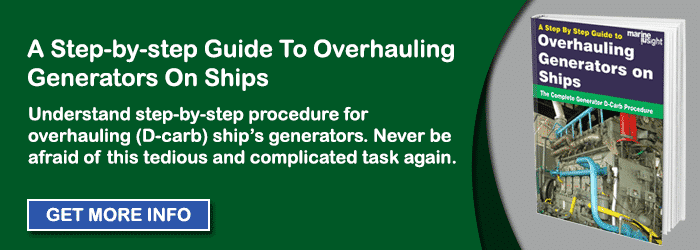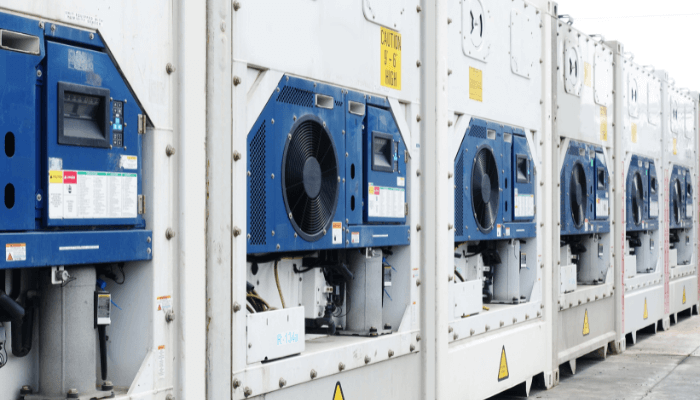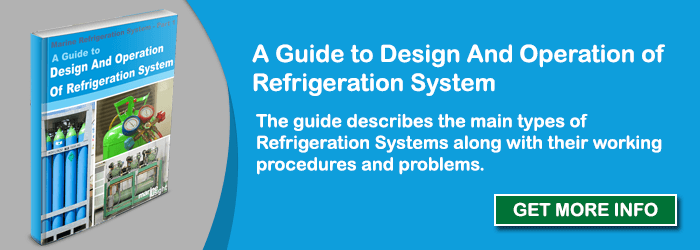Everything You Ever Wanted to Know About Container Refrigeration Unit
A reefer container is an enclosed unit used for transporting temperature sensitive cargo. The container requires an external power supply for its operation. The article describes everything you ever wanted to know about container refrigeration units.
When reefer containers are loaded in ships, the power supply is provided from the power generated from the D.G sets of the vessel. If the vessel’s generator capacity is not enough to support the additional power consumption of the refrigerated containers (in case of old ship or unavailability of generator due to overhauling etc.), mobile power packs are installed on the ship.
There are a different variety of refrigerated shipping containers present in the market today. A particular type is used depending upon the efficiency requirement and the cargo they need to carry.
Types of Refrigerated Shipping Containers are:
1. Closed Reefer: This is a conventional type refrigerated container. It comes in one-piece with integral front wall and an all-electric automatic cooling and heating unit for ISO sea-going containers.
2. Modified/ Controlled Atmosphere (MA/CA) reefer containers: These type of insulated shipping containers maintain a constant atmosphere by replacing consumed oxygen using an air exchange system, keeping an ideal atmosphere in equilibrium with the product’s deterioration rate.
3. Automatic Fresh Air Management Containers: Popularly known by its acronym – AFAM reefer containers uses advanced technology to regulate the air combination by automatically adjusting the scale of fresh air exchange. It works similar to Controlled Atmosphere refrigerated container, controlling the composition of oxygen, carbon dioxide and others. The controls of the AFAM refrigerated containers can be adjusted to influence and extend the shelf lives of the cargo they carry.
Some important points about container refrigeration are:
- Container Refrigeration unit is fitted in front of the container and it serves as a container front wall.
- Some units are dual voltage, designed to operate on 190/230 or 380/460 volts A.C, 3 phase, 50-60 hertz power.
- Operating control power is provided by single phase transformer which steps down the A.C supply power source to 24 volts, 1 phase control power.
Related reading: How perishable food is transported using refer ships?
Understanding the Basic Sections of Refer Unit
1. Compressor Section
- Consists of a compressor (with H.P switch) and power cable storage compartment. Power transformer may be an option where the ship supply differs.
- It also contain modulating and suction solenoid valve (for controlling the quantity of gas flow).
- Safety fittings in the section are- moisture liquid indicator, pressure relief valve, filter drier etc.
- Safety of the system is further enhanced by electronic monitoring with the help of following sensors- Compressor suction and discharge sensor, supply air temperature sensor, supply recorder sensor, ambient sensor.
Related reading: What are safety devices on a refrigeration system of a ship?
2. Condenser Section
- The condenser section contains condenser fan and its motor, an air cooled condenser coil and condenser saturation sensor.
- For air cooled condenser air is normally pulled from bottom and discharged horizontally through centre of the unit.
- Some units consists of water cooled condenser /receiver. This unit is expensive.
Related reading: Heat exchangers on ship explained
3. Evaporator Section
- This section contains temperature sensing bulb, return recorder bulb sensor and a thermostatic expansion valve (for flow of refrigerant and maintenance of inside temperature).
- Assembly consist of evaporator coil and heater, drain pan and heater, defrost and heat transmission switches.
- The evaporator fan circulates air throughout the container by pulling air in top of refrigeration unit and directing air through evaporator coil where it’s either heated or cooled and is then discharged out at the bottom of refrigeration unit into the container.
Related reading: Understanding capacity control in ship’s air conditioning and refrigeration system
4. Fresh air Make up Vent
- Purpose of this vent is to provide ventilation for commodities that requires fresh air circulation and must be closed when transporting frozen foods.
- Air exchange depends upon static pressure differential which will vary depending upon how container is loaded.
Safety and Operating Precaution
An injury, no matter how small, should never go unattended. Always obtain first aid or medical attention immediately.
- Always wear safety gloves and glasses while working on any unit and also when charging refrigerant.
- Keep hand, tools, and clothing clear from evaporator and condenser fan.
- No work should be performed on any unit until all circuit breaker and start-stop switches are turned off and power supply disconnected.
- Do not bypass any electrical safety device.
- When performing arc welding on unit or condenser, disconnect all wire harness connection from the module in control box. Do Not remove wire harness from the module unless you are grounded to a unit frame with a static safe wrist strap.
- In case of electrical fire, open circuit switch and extinguish it with CO2 extinguisher.
- Officer and crew responsible for refrigerated shipping container must know the hazard related to refrigerant gas such as – Phosgene gas hazard (due to high temperature), Asphyxiation hazard in non-ventilated spaces etc.
- Safely handle the compressed gas bottles when charging refrigerant
Most common Problem in refrigerated shipping containers – Leakage.
The leakage of refrigerant is the most common problem faced by onboard staff during the voyage. Following tests must be carried out to detect leakages:
1. Soap water test: This is done on low-pressure line by spraying soapy water on the troubled pipe or space. If the soapy water comes in contact with leakage area, bubbles will form
2. Halide lamp test: This is used for all pressure lines
3. Electronic leak detector: It is a portable unit to carry out leak detection. It should not be used in a noisy area.
4. Permanent or fixed type leak detection unit: Some reefer containers come with fixed type leak detection unit which gives audio-visual alarm in case of leakage
*Note: All the pipes in the refrigerated container unit are insulated. Before testing the piping for leakage, make a small hole in the insulation and check the leakage near the hole (using soap/ halide lamp or electronic detector). Once the leakage is confirmed, then remove the insulation of the complete pipe section to spot the leakage area.
Disclaimer: The authors’ views expressed in this article do not necessarily reflect the views of Marine Insight. Data and charts, if used, in the article have been sourced from available information and have not been authenticated by any statutory authority. The author and Marine Insight do not claim it to be accurate nor accept any responsibility for the same. The views constitute only the opinions and do not constitute any guidelines or recommendation on any course of action to be followed by the reader.
The article or images cannot be reproduced, copied, shared or used in any form without the permission of the author and Marine Insight.

About Author
Raunek Kantharia is a marine engineer turned maritime writer and entrepreneur. After a brief stint at the sea, he founded Marine Insight in 2010. Apart from managing Marine Insight, he also writes for a number of maritime magazines and websites.
Do you have info to share with us ? Suggest a correction
Subscribe To Our Newsletters
By subscribing, you agree to our Privacy Policy and may receive occasional deal communications; you can unsubscribe anytime.







Excellent post. I used to be checking continuously this weblog and I am impressed! Very helpful info particularly the remaining part 🙂 I care for such information much. I was seeking this certain information for a very long time. Thank you and good luck.
Thanks for pointing out that a reefer container is an enclosed unit used for transporting temperature sensitive cargo. You also said that when reefer containers are loaded into ships, the power supply is provided from the power generated from the DG sets of the ship. I think it’s a good idea to choose a refrigeration container that has updated security and locks to keep your cargo safe.
First of all thanks for all the useful information in this post. I would like to know where exactly are loaded the reefer containers in the vessel if there is any specific location. Also would like to know whether this reefer contairnes have handling priority in the terminal over the standard ones.
Thanks and warm regards,
Victor A.
@Vicotr: There are bays provided in the cargo loading area of the ship fitted with reefer socket to provide the power supply to the reefer container.
The loading will done as per the loading plan and hence the handling priority may vary accordingly.
WHAT IS THE STANDARD CONFIGURATION FOR REEFER SOCKETS . ON WHAT STANDARD BASIS WE ARE CONFIGURING REEFER SOCKETS.
I love this informations, how can i get in touch to in case i encounter any problem……??
Pliz , am Ronald ojok
@Ojok: I am glad that the info is useful to you. Please make use our forums for questions and discussion- https://forums.marineinsight.com
I have just launched a cool new product for changing out the nose mount Gensets with a single operator. I would like to get in touch with you to share our information. I think this would be great content for this audience.
Great article with a nice overview of containers and their parts. Have you written about people converting containers to living spaces? Thanks.
I’m curious if your containers are used for pharmaceuticals? Thank you for your response.
We have a reefer on our dock at a food processing facility. The noise is an issue- how much airflow does a reefer need? We want to build a sound dampening box but I don’t know how to prevent overheating for the compressor.
How much airflow is there on a ship? What is the ambient temp?
Has anyone figured out how to reduce the noise without hurting the function of a ref container?
Thanks so much! Any sources on where I can buy a unit?
thanks my question is, do i need to shut down the reefer unit while removing something like for 10 minutes only, if the answer is no, then why?
@Paul: You might not need to shut down but isolate some sections, depending upon the area and job you are carrying out.
The Refrigerated Transport Container market revenue was xx.xx Million USD in 2014, grew to xx.xx Million USD in 2018, and will reach xx.xx Million USD in 2024, with a CAGR of x.x% during 2019-2024. Based on the Refrigerated Transport Container industrial chain, this report mainly elaborates on the definition, types, applications and major players of the Refrigerated Transport Container market in detail. Deep analysis of market status (2014-2019), enterprise competition pattern, advantages, and disadvantages of enterprise Products, industry development trends (2019-2024), regional industrial layout characteristics and macroeconomic policies, industrial policy has also be included. From raw materials to downstream buyers of this industry will be analyzed scientifically, the feature of product circulation and sales channel will be presented as well. In a word, this report will help you to establish a panorama of industrial development and characteristics of the Refrigerated Transport Container market.
Is it safe to transport hazardous chemical substance together with perishable goods in one ship?, what if there be a leakage from the hazardous chemical. Thank you . jeziel Obinna
What nationality is SEACOLD Refrigeration units on Sea Contontainers?please.
The maintenance of integral reefers on board ship container vessels it will be a big responsible for ETO’s onboard. That was my experienced during operation from port of loading to port of destination.